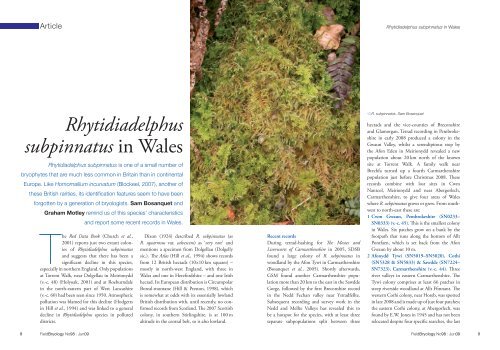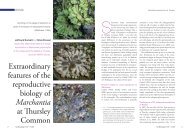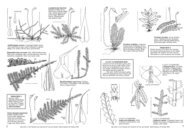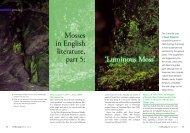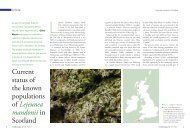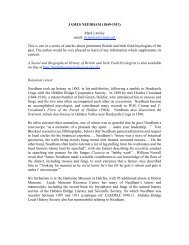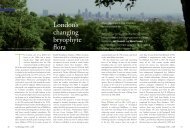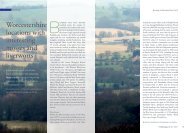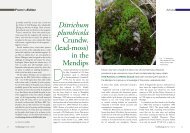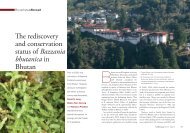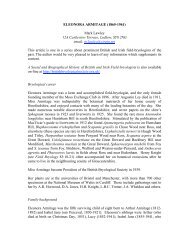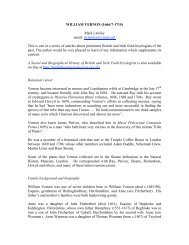Rhytidiadelphus subpinnatus in Wales
Rhytidiadelphus subpinnatus in Wales
Rhytidiadelphus subpinnatus in Wales
You also want an ePaper? Increase the reach of your titles
YUMPU automatically turns print PDFs into web optimized ePapers that Google loves.
Article<br />
<strong>Rhytidiadelphus</strong><br />
<strong>subp<strong>in</strong>natus</strong> <strong>in</strong> <strong>Wales</strong><br />
<strong>Rhytidiadelphus</strong> <strong>subp<strong>in</strong>natus</strong> is one of a small number of<br />
bryophytes that are much less common <strong>in</strong> Brita<strong>in</strong> than <strong>in</strong> cont<strong>in</strong>ental<br />
Europe. Like Homomallium <strong>in</strong>curvatum (Blockeel, 2007), another of<br />
these British rarities, its identification features seem to have been<br />
forgotten by a generation of bryologists. Sam Bosanquet and<br />
Graham Motley rem<strong>in</strong>d us of this species’ characteristics<br />
and report some recent records <strong>in</strong> <strong>Wales</strong>.<br />
The Red Data Book (Church et al.,<br />
2001) reports just two extant colonies<br />
of <strong>Rhytidiadelphus</strong> <strong>subp<strong>in</strong>natus</strong><br />
and suggests that there has been a<br />
significant decl<strong>in</strong>e <strong>in</strong> this species,<br />
especially <strong>in</strong> northern England. Only populations<br />
at Torrent Walk, near Dolgellau <strong>in</strong> Meirionydd<br />
(v.-c. 48) (Holyoak, 2001) and at Roeburndale<br />
<strong>in</strong> the north-eastern part of West Lancashire<br />
(v.-c. 60) had been seen s<strong>in</strong>ce 1950. Atmospheric<br />
pollution was blamed for this decl<strong>in</strong>e (Hodgetts<br />
<strong>in</strong> Hill et al., 1994) and was l<strong>in</strong>ked to a general<br />
decl<strong>in</strong>e <strong>in</strong> <strong>Rhytidiadelphus</strong> species <strong>in</strong> polluted<br />
districts.<br />
Dixon (1924) described R. <strong>subp<strong>in</strong>natus</strong> (as<br />
R. squarrosus var. calvescens) as ‘very rare’ and<br />
mentions a specimen from Dolgellau (Dolgelly<br />
sic.). The Atlas (Hill et al., 1994) shows records<br />
from 12 British hectads (10x10 km squares) –<br />
mostly <strong>in</strong> north-west England, with three <strong>in</strong><br />
<strong>Wales</strong> and one <strong>in</strong> Herefordshire – and one Irish<br />
hectad. Its European distribution is Circumpolar<br />
Boreal-montane (Hill & Preston, 1998), which<br />
is somewhat at odds with its essentially lowland<br />
British distribution with, until recently, no confirmed<br />
records from Scotland. The 2007 Scottish<br />
colony, <strong>in</strong> southern Stirl<strong>in</strong>gshire, is at 100 m<br />
altitude <strong>in</strong> the central belt, so is also lowland.<br />
Recent records<br />
Dur<strong>in</strong>g tetrad-bash<strong>in</strong>g for The Mosses and<br />
Liverworts of Carmarthenshire <strong>in</strong> 2005, SDSB<br />
found a large colony of R. <strong>subp<strong>in</strong>natus</strong> <strong>in</strong><br />
woodland by the Afon Tywi <strong>in</strong> Carmarthenshire<br />
(Bosanquet et al., 2005). Shortly afterwards,<br />
GSM found another Carmarthenshire population<br />
more than 20 km to the east <strong>in</strong> the Sawdde<br />
Gorge, followed by the first Breconshire record<br />
<strong>in</strong> the Nedd Fechan valley near Ystradfellte.<br />
Subsequent record<strong>in</strong>g and survey work <strong>in</strong> the<br />
Nedd and Mellte Valleys has revealed this to<br />
be a hotspot for the species, with at least three<br />
separate subpopulations split between three<br />
<strong>Rhytidiadelphus</strong> <strong>subp<strong>in</strong>natus</strong> <strong>in</strong> <strong>Wales</strong><br />
v R. <strong>subp<strong>in</strong>natus</strong>. Sam Bosanquet<br />
hectads and the vice-counties of Breconshire<br />
and Glamorgan. Tetrad record<strong>in</strong>g <strong>in</strong> Pembrokeshire<br />
<strong>in</strong> early 2008 produced a colony <strong>in</strong> the<br />
Gwaun Valley, whilst a serendipitous stop by<br />
the Afon Eden <strong>in</strong> Meirionydd revealed a new<br />
population about 20 km north of the known<br />
site at Torrent Walk. A family walk near<br />
Brechfa turned up a fourth Carmarthenshire<br />
population just before Christmas 2008. These<br />
records comb<strong>in</strong>e with lost sites <strong>in</strong> Cwm<br />
Nantcol, Meirionydd and near Abergorlech,<br />
Carmarthenshire, to give four areas of <strong>Wales</strong><br />
where R. <strong>subp<strong>in</strong>natus</strong> grows or grew. From southwest<br />
to north-east these are:<br />
1 Cwm Gwaun, Pembrokeshire (SN0233–<br />
SN0333) (v.-c. 45). This is the smallest colony<br />
<strong>in</strong> <strong>Wales</strong>. Six patches grow on a bank by the<br />
footpath that runs along the bottom of Allt<br />
Pontfaen, which is set back from the Afon<br />
Gwaun by about 10 m.<br />
2 Afonydd Tywi (SN5019–SN5020), Cothi<br />
(SN5328 & SN5833) & Sawdde (SN7224–<br />
SN7323), Carmarthenshire (v.-c. 44). Three<br />
river valleys <strong>in</strong> eastern Carmarthenshire. The<br />
Tywi colony comprises at least 66 patches <strong>in</strong><br />
steep riverside woodland at Allt Ff<strong>in</strong>nant. The<br />
western Cothi colony, near Horeb, was spotted<br />
<strong>in</strong> late 2008 and is made up of just four patches;<br />
the eastern Cothi colony, at Abergorlech, was<br />
found by E.W. Jones <strong>in</strong> 1945 and has not been<br />
relocated despite four specific searches, the last<br />
8 FieldBryology No98 | Jun09 FieldBryology No98 | Jun09 9
<strong>Rhytidiadelphus</strong> <strong>subp<strong>in</strong>natus</strong> <strong>in</strong> <strong>Wales</strong><br />
<strong>in</strong> late 2008. The Sawdde colony is widespread<br />
between Turkey Cottage and Pont ar Llechau<br />
<strong>in</strong> mossy turf on ledges by the river. The Tywi<br />
and Sawdde colonies have the largest number<br />
of patches known <strong>in</strong> <strong>Wales</strong> and the Sawdde<br />
colony is the only one where non-hybrid<br />
sporophytes have been found (see Ecology and<br />
status, below).<br />
3 Dyffrynnoedd Nedd a Mellte (Neath<br />
Waterfalls area), Breconshire (v.-c. 42) &<br />
Glamorgan (v.-c. 41) (SN8908, SN9108,<br />
SN9110). An extensive area of oak and ash<br />
woodland along four ma<strong>in</strong> river valleys, with<br />
colonies of R. <strong>subp<strong>in</strong>natus</strong> recorded <strong>in</strong> two<br />
of these. The colony by the Nedd Fechan<br />
above Pont Mel<strong>in</strong>-Fach consists of 12 patches<br />
grow<strong>in</strong>g on a steep bank by the ma<strong>in</strong> footpath<br />
<strong>in</strong> oak woodland. Further down the valley,<br />
near Pontneddfechan, below where the Afon<br />
Pyrdd<strong>in</strong> jo<strong>in</strong>s the Nedd Fechan to form<br />
the Afon Nedd, R. <strong>subp<strong>in</strong>natus</strong> grows on<br />
both the Breconshire and Glamorgan sides<br />
of the river, aga<strong>in</strong> immediately adjacent to<br />
the ma<strong>in</strong> footpaths and <strong>in</strong> oak woodland.<br />
The Glamorgan colony consists of a s<strong>in</strong>gle<br />
patch with some scattered shoots, but on the<br />
Breconshire side more than 15 patches have<br />
been noted. A further colony occurs scattered<br />
along the eastern side of the Afon Mellte below<br />
Craig y Dd<strong>in</strong>as <strong>in</strong> both oak and ash woodland.<br />
Here, 14 patches occur alongside the footpath<br />
and also <strong>in</strong> a less vulnerable position high<br />
above the path. Most of the colonies <strong>in</strong> the<br />
‘Waterfalls’ area have been casual f<strong>in</strong>ds whilst<br />
visit<strong>in</strong>g the site for reasons other than for<br />
purely bryological survey – it seems likely<br />
that a targeted survey could f<strong>in</strong>d this species<br />
to be more widespread throughout these river<br />
valleys.<br />
4 Dolgellau & Rh<strong>in</strong>ogs (SH62–SH72), Meirionydd<br />
(v.-c. 48). This is the area of <strong>Wales</strong><br />
9<br />
8<br />
7<br />
6<br />
5<br />
4<br />
3<br />
2<br />
1<br />
0<br />
9<br />
8<br />
7<br />
6<br />
5<br />
4<br />
3<br />
2<br />
1<br />
0<br />
9<br />
8<br />
7<br />
7 8 9 0 1 2 3 4 5 6 7 8 9 0 1 2 3 4 5<br />
n Distribution of R. <strong>subp<strong>in</strong>natus</strong> <strong>in</strong> <strong>Wales</strong> plotted at the<br />
5-km level. Pale blue dots, pre-1970 records; dark blue<br />
dots, post-1970 records. Sam Bosanquet<br />
from which R. <strong>subp<strong>in</strong>natus</strong> has been known<br />
for longest. It was collected several times from<br />
Cwm Artro and Cwm Nantcol (SH6427)<br />
between 1904 and 1912, but has not been<br />
seen there s<strong>in</strong>ce. Holyoak (2001) revisited the<br />
well-known site at Torrent Walk (SH7518),<br />
where R. <strong>subp<strong>in</strong>natus</strong> was discovered <strong>in</strong> 1876,<br />
and reported it ‘on a bank above the Torrent<br />
Walk’. SDSB stopped by the Afon Eden north<br />
of Ganllwyd (SH7226) dur<strong>in</strong>g a journey to<br />
north <strong>Wales</strong> and found frequent patches on<br />
flat ground on the east bank of the river.<br />
Identification<br />
Smith (1978) says that about half the 20th<br />
century specimens collected as R. <strong>subp<strong>in</strong>natus</strong><br />
were R. squarrosus, and it is clear that there<br />
has been considerable confusion over the<br />
identification of R. <strong>subp<strong>in</strong>natus</strong>. This appears<br />
to be because British bryologists have come<br />
to th<strong>in</strong>k of R. <strong>subp<strong>in</strong>natus</strong> as look<strong>in</strong>g like a<br />
small R. squarrosus, rather than hav<strong>in</strong>g its own<br />
dist<strong>in</strong>ctive appearance. Dixon (1924) po<strong>in</strong>ts out<br />
the ‘great resemblance <strong>in</strong> its strongly marked forms<br />
to Hylocomium brevirostre’, which seems to<br />
have been forgotten <strong>in</strong> subsequent decades and<br />
was not mentioned by Smith (1978, 2004). Its<br />
dist<strong>in</strong>ctive appearance – with wide, short leaves<br />
on most branches, but strongly squarrose leaves<br />
at the shoot tip and on some branch tips – makes<br />
plants of R. <strong>subp<strong>in</strong>natus</strong> look like Loeskeobryum<br />
(=Hylocomium) brevirostre but with R. squarrosus<br />
tips (see photos). Closer exam<strong>in</strong>ation reveals<br />
squarrose stem leaves, which are like those of<br />
R. squarrosus but spread out from the base, rather<br />
than clasp<strong>in</strong>g the stem. This makes the red stem<br />
stand out more than that of R. squarrosus, and<br />
also reveals a lack of paraphyllia, dist<strong>in</strong>guish<strong>in</strong>g R.<br />
<strong>subp<strong>in</strong>natus</strong> from L. brevirostre. Individual stems<br />
are, as the name suggests, subp<strong>in</strong>nate, although<br />
often with irregularly branched sections. The<br />
overall colour of dry patches tends to be pale<br />
green, sometimes with greyish or even salmon<br />
p<strong>in</strong>k tones; with moist plants the stems appear<br />
bright red. Forms of R. squarrosus <strong>in</strong> which<br />
branch leaves are not particularly squarrose are<br />
sometimes encountered. These plants often look<br />
rather etiolated, with <strong>in</strong>dividual branches rather<br />
th<strong>in</strong>, rounded and taper<strong>in</strong>g towards the tip, unlike<br />
the more robust and sometimes complanate<br />
appearance of R. <strong>subp<strong>in</strong>natus</strong> branches.<br />
Ecology and status<br />
All of the Welsh colonies of R. <strong>subp<strong>in</strong>natus</strong> are<br />
<strong>in</strong> steep-sided, wooded river valleys <strong>in</strong> hilly<br />
districts. Patches up to 100x80 cm <strong>in</strong> size<br />
grow on banks or over rocks or well-rotted<br />
tree stumps, sometimes form<strong>in</strong>g mounds that<br />
are <strong>in</strong>termixed with other bulky pleurocarpous<br />
mosses. Typical associates <strong>in</strong>clude Brachythecium<br />
<strong>Rhytidiadelphus</strong> <strong>subp<strong>in</strong>natus</strong> <strong>in</strong> <strong>Wales</strong><br />
n Habit and close-ups of R. <strong>subp<strong>in</strong>natus</strong>. Sam Bosanquet<br />
rutabulum, Cirriphyllum piliferum, Eurhynchium<br />
striatum, K<strong>in</strong>dbergia praelonga, R. loreus, R.<br />
triquetrus, Thuidium tamarisc<strong>in</strong>um and the<br />
liverwort Plagiochila asplenioides. All colonies<br />
are on the floor of broadleaved woodlands with<br />
ash (Frax<strong>in</strong>us excelsior), hazel (Corylus avellana)<br />
and oak (Quercus sp.) as the pr<strong>in</strong>cipal trees.<br />
Three dist<strong>in</strong>ct niches on the woodland floor<br />
10 FieldBryology No98 | Jun09 FieldBryology No98 | Jun09 11
<strong>Rhytidiadelphus</strong> <strong>subp<strong>in</strong>natus</strong> <strong>in</strong> <strong>Wales</strong><br />
n Habitats of R. <strong>subp<strong>in</strong>natus</strong> <strong>in</strong> Nedd Fechan (top) and<br />
the Cwm Gwaun valley (bottom). Sam Bosanquet<br />
are exploited: flat ground immediately adjacent<br />
to a river, where flood<strong>in</strong>g is likely to be annual;<br />
steep ground above the river, with records up<br />
to 20 m above the river level; and steep banks<br />
by footpaths, which tend to be just above<br />
the flood zone. The last of these niches is<br />
highly vulnerable to any footpath diversions<br />
or widen<strong>in</strong>g works.<br />
The Atlas (Hill et al., 1994) says that the sporophytes<br />
of R. <strong>subp<strong>in</strong>natus</strong> are unknown <strong>in</strong> Brita<strong>in</strong>.<br />
Holyoak (2001) reported a small, shrivelled<br />
capsule at Torrent Walk, where all the R. <strong>subp<strong>in</strong>natus</strong><br />
population is female. The nearest male<br />
<strong>Rhytidiadelphus</strong> was R. loreus, and Holyoak<br />
suggests this was most probably the male parent<br />
of the therefore hybrid sporophyte. However,<br />
GSM found several patches of R. <strong>subp<strong>in</strong>natus</strong> <strong>in</strong><br />
Cwm Sawdde with healthy look<strong>in</strong>g sporophytes<br />
that had dehisced by mid-April 2005 (Bosanquet<br />
et al., 2005). Male plants were present both there<br />
and at the other extant Carmarthenshire site by<br />
the Afon Tywi. Given the strength of the Cwm<br />
Sawdde population and the presence of both<br />
male and female plants, it seems clear that the<br />
sporophytes there are not of hybrid orig<strong>in</strong>, so<br />
they represent the first confirmed fruit<strong>in</strong>g of<br />
R. <strong>subp<strong>in</strong>natus</strong> <strong>in</strong> Brita<strong>in</strong>.<br />
The ma<strong>in</strong> threats to R. <strong>subp<strong>in</strong>natus</strong> appear to<br />
be livestock graz<strong>in</strong>g and forestry works. The last<br />
colony to be discovered, by the Afon Cothi near<br />
Horeb, is <strong>in</strong> a typical situation on narrow river<br />
flats at the foot of a very steep wooded slope,<br />
but the ground is much grassier than would be<br />
expected. R. squarrosus is abundant <strong>in</strong> this grassy<br />
turf, mixed with more typical woodland mosses,<br />
such as Atrichum undulatum, C. piliferum, R.<br />
loreus, R. triquetrus and T. tamarisc<strong>in</strong>um, and<br />
R. <strong>subp<strong>in</strong>natus</strong> is limited to four patches. This<br />
wood is regularly sheep-grazed, which is thought<br />
to encourage grass growth and R. squarrosus,<br />
and it seems as though this is caus<strong>in</strong>g an active<br />
shift from a riparian woodland ground layer <strong>in</strong><br />
which R. <strong>subp<strong>in</strong>natus</strong> can grow, to a flora more<br />
ak<strong>in</strong> to a pasture, which is unsuitable for this rare<br />
moss. It is worth not<strong>in</strong>g that the two strongest<br />
populations, by the Afonydd Tywi and Sawdde,<br />
are <strong>in</strong> narrow strips of woodland between the<br />
river and a road, which have probably not seen a<br />
sheep for decades.<br />
The other Cothi Valley site, where E.W.<br />
Jones found R. <strong>subp<strong>in</strong>natus</strong> <strong>in</strong> 1945, has been<br />
extensively modified by forestry operations.<br />
The north bank is now largely occupied by an<br />
ash plantation, the floor of which is strewn with<br />
branch debris from a recent th<strong>in</strong>n<strong>in</strong>g, whilst<br />
the south bank has been coniferized apart from<br />
a narrow strip by the river. Two visits to each<br />
bank have failed to produce R. <strong>subp<strong>in</strong>natus</strong>, and<br />
it seems to have disappeared, perhaps because of<br />
changes <strong>in</strong> humidity or light levels.<br />
Recent records of R. <strong>subp<strong>in</strong>natus</strong> <strong>in</strong> four widely<br />
separated areas of <strong>Wales</strong> suggest that the decl<strong>in</strong>e<br />
suggested by the Red Data Book and the Atlas may<br />
not have been as dramatic as was first thought.<br />
Indeed, it seems highly likely that the loss of<br />
knowledge of the appearance and specific habitat<br />
of R. <strong>subp<strong>in</strong>natus</strong> <strong>in</strong> Brita<strong>in</strong> caused this apparent<br />
decl<strong>in</strong>e, as was the case with Homomallium<br />
<strong>in</strong>curvatum (Blockeel, 2007). Nevertheless, it is<br />
far from ubiquitous <strong>in</strong> <strong>Wales</strong> and is likely to be a<br />
genu<strong>in</strong>ely scarce, if not rare, species <strong>in</strong> Brita<strong>in</strong> as a<br />
whole. SDSB consciously searched for it for 3<br />
years <strong>in</strong> Pembrokeshire before f<strong>in</strong>ally discover<strong>in</strong>g<br />
a colony, and several searches <strong>in</strong> apparently suit-<br />
able habitat <strong>in</strong> Cardiganshire have failed to produce<br />
any colonies. Remarkably, all of the Welsh<br />
populations of R. <strong>subp<strong>in</strong>natus</strong> are protected by<br />
SSSIs, all but one of which were designated<br />
before the species was found, and several of which<br />
<strong>in</strong>clude bryophyte assemblages as qualify<strong>in</strong>g<br />
features. Provid<strong>in</strong>g landowners and people<br />
ma<strong>in</strong>ta<strong>in</strong><strong>in</strong>g footpaths <strong>in</strong> these valley woodlands<br />
<strong>Rhytidiadelphus</strong> <strong>subp<strong>in</strong>natus</strong> <strong>in</strong> <strong>Wales</strong><br />
are made aware of the presence of R. <strong>subp<strong>in</strong>natus</strong>,<br />
its cont<strong>in</strong>ued existence <strong>in</strong> <strong>Wales</strong> seems assured.<br />
It seems very unlikely that R. <strong>subp<strong>in</strong>natus</strong><br />
should be relatively widespread <strong>in</strong> <strong>Wales</strong> but<br />
restricted to a s<strong>in</strong>gle site <strong>in</strong> England. Perhaps<br />
English bryologists could seek it specifically<br />
<strong>in</strong> humid, wooded river valleys, bear<strong>in</strong>g its<br />
resemblance to Loeskeobryum brevirostre <strong>in</strong> m<strong>in</strong>d.<br />
Sam D.S. Bosanquet<br />
Cnwc y Llwyn, Brechfa, Carmarthen,<br />
Carmarthenshire SA32 7QR<br />
Graham S. Motley<br />
St Helen’s Road, Abergavenny,<br />
Monmouthshire NP7 5UU<br />
12 FieldBryology No98 | Jun09 FieldBryology No98 | Jun09 13<br />
References<br />
Blockeel, T.L. (2007). The status and habitat of Homomallium<br />
<strong>in</strong>curvatum <strong>in</strong> the north of England. Field Bryology 91,<br />
2–7.<br />
Bosanquet, S.D.S., Graham, J.J. & Motley, G.S. (2005). The<br />
Mosses and Liverworts of Carmarthenshire. D<strong>in</strong>gestow: Private<br />
publication.<br />
Church, J.M., Hodgetts, N.G., Preston, C.D. & Stewart, N.F.<br />
(2001). British Red Data Books Mosses and Liverworts.<br />
Peterborough: Jo<strong>in</strong>t Nature Conservation Committee.<br />
Dixon, H.N. (1924). The Student’s Handbook of British Mosses.<br />
Eastbourne: V.V. Sumfield.<br />
Hill, M.O. & Preston, C.D. (1998). The geographical<br />
relationships of British and Irish bryophytes. Journal of<br />
Bryology 20, 127–226.<br />
Hill, M.O., Preston, C.D. & Smith, A.J.E. (editors) (1994).<br />
Atlas of the Bryophytes of Brita<strong>in</strong> and Ireland, Vol. 3. Mosses<br />
(Diplolepideae). Colchester: Harley Books.<br />
Holyoak, D.T. (2001). A hybrid sporophyte on <strong>Rhytidiadelphus</strong><br />
<strong>subp<strong>in</strong>natus</strong>. Bullet<strong>in</strong> of the British Bryological Society 76,<br />
56–58.<br />
Smith, A.J.E. (1978). The Moss Flora of Brita<strong>in</strong> and Ireland.<br />
Cambridge: Cambridge University Press.<br />
Smith, A.J.E. (2004). The Moss Flora of Brita<strong>in</strong> and Ireland, 2nd<br />
edn. Cambridge: Cambridge University Press.


